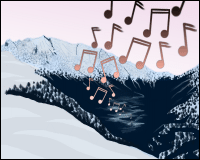'An Alpine Symphony' by Richard Strauss
Created | Updated May 5, 2006

Richard Strauss's Eine Alpensinfonie ('An Alpine Symphony') was written in 1915. Despite its title, it is not a symphony in the generally accepted sense of the word. Symphonies have movements which follow set forms (sonata, scherzo, etc). This work is a 'tone poem', a musical form which Strauss specialised in for about 20 years of his life. Tone poems attempt to paint a picture in musical terms, using instruments alone, in this case the instruments of the orchestra. There are usually no sung words, although tone poems normally make use of explanatory titles. Eine Alpensinfonie is Strauss's last and longest tone poem, but is quite easy to understand.
The work lasts about 45 minutes and it features a large orchestra with a lot of brass and low woodwind such as bassoons and bass clarinets. It tells the story of a group of mountain climbers ascending one of the Alps. In the course of one day, they climb to the summit and descend again. The music is continuous - there are no breaks.
Highlights
Strauss divided the music into 22 separate sections, each with a descriptive title, such as 'Lost in the Thicket and Undergrowth'. These range from 15 seconds long to as much as five and-a-half minutes. Since the sections run into each other without a break, it is almost impossible to follow them exactly unless you have the score and are an expert reader of music, so it is probably best to ignore them and just watch out for the following highlights:
Night - The work starts with a deep brooding theme played on low-pitched woodwinds, as the climbers start their day. This theme is a recurring motif throughout the work.
Sunrise - About two minutes into the work, the Sun comes up with a glorious theme of its own, triumphant and clear on the brass instruments. This theme is also heard throughout the rest of the work.
A party of hunters gallop past, blowing their horns.
As the climbers wander through the high alpine pastures, the bells on the grazing cows can be heard clanging.
The melodrama of crossing a glacier and arriving at the summit is reflected in the music, but it is not clear exactly when the summit is reached.
The party starts to head back down the mountain, but they are overtaken by a thunderstorm. First we hear the falling of the big raindrops that precede the storm. Then the thunder and lightning comes. The wind rises and we can hear its screams played on the violins. The fury of the storm eventually abates.
The Sun sets and there is a glorious five minutes of pure beauty as the colours in the sky change and fade. This is the true climax of the work and shows Strauss at his best.
The work ends with night, the same deep dark theme with which it started.
Programme Music
The technical term for this sort of a work is 'Programme Music'. The music is intended to illustrate an idea, a story or an emotion. In this case, the music tells a literal story of some climbers and a mountain. This is in stark contrast to works like the preludes and fugues of Johann Sebastian Bach, where there is no meaning - the music exists purely for its own sake and is known as 'Absolute Music'. Programme music is often derided as being shallow, but many composers have tried their hand at it, even the great Beethoven (in his Pastoral Symphony).
But is Eine Alpensinfonie just a literal story? At the end of the work, we are left with a strong feeling that this isn't just about some guys going up a mountain. It doesn't end with the climbers arriving back to their homes, drinks all round and a big celebration. Instead, the people concerned are forgotten as the Sun sets and the focus of the work moves to the glory of the sky and the world around us. Perhaps what we are really witnessing here is the story of a human life, with its jollity, its fear, its glory, beginning and ending in darkness.

